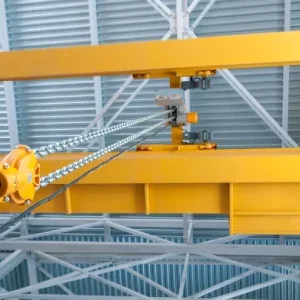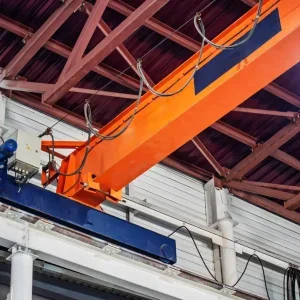The crane, a 12m-span double-girder EOT, had been installed in the 1980s by Genius Ijmuiden to aid the construction of production equipment. It was installed in the oxy-steel factory number two at Corus steelworks in Ijmuiden, Netherlands. The crane has a maximum safe working load of 63t with the main hoist and 10t with an auxiliary hoist.
Every day the factory produces about 60 ladles of liquid steel, each weighing 300t. Every ladleful of liquid steel – with a temperature of about 1500° Celsius – is treated in one of the two vacuum pan treatment installations. Here the liquid steel’s alloy is checked and then sent on.
Maintenance and repair on both these vacuum installations needs to be done every 72 hours, or sooner if problems of any kind occur. Often the crane, mounted near the roof 44m above the floor, is used to lift spare parts, tools and equipment to aid in repair.
Corus decided that the crane was no longer fast enough to deal with the increasing production level. The fact that spare parts were getting rare made it easy to make this major step.
Corus made clear how it wanted the crane to function. Maximum hoisting speeds should depend on the load: more than 40t, hoisting speed should be variable up to 5m/min, hoisting speed for loads between 20t and 40t should vary up to 8m/min, and loads less than 20t should travel up to 12m/min. Corus also wanted a frequency inverter to smoothen long travel and trolley travel speeds, which remained at 20 m/min and 12 m/min. Finally a central diagnostic system should be implemented to make fault finding easier.
This was the brief presented to bidders for the upgrade contract. There were two other twists. During the refurbishment the crane could only be shut down during daytime. At night and when production called for it, Corus personnel had to be able to use the crane in a safe and normal way to do maintenance or repair work on the vacuum installation.
Even though KCI Konecranes doesn’t do any maintenance at the factory, it won the contract because it was the only company that would carry out the work in the daytime.
Corus required KCI Konecranes to plan out the job, write a protocol for the job, and then follow the protocol. KCI Konecranes site mechanics supervisor Christ Oerlemans wrote up six protocols, each one or two pages, for different parts of the job.
The upgrade
To avoid interfering with operations, rather than replacing the existing cabinets and wiring on the south girder, a completely new electrical installation was built new on the north girder. Because a walkway runs across the middle of the north girder, the electrical cabinets were installed on a cantilever supported by steel beams that had to be bolted against the girder to support the 2t weight of the four new electrical cabinets. As soon as the support structure and the cabinets were put in place, the entire wiring system was renewed. Wires were re-strung from the cabinet to the end points – motors and some switches.
As soon as all wiring was connected in the cabinets it was all tested and tested. The four weeks of preparation were followed by an intense 72 hours during which the complete new installation had to be connected to partly new and partly existing equipment.
While the electricians were busy making all the connections right, the mechanics had their own work. To achieve the new hoisting speeds it was necessary to replace the old 63 kW motor and gearbox with a new 90 kW motor and gearbox weighing 3.1t, as well as a new hoisting disc brake.
Overnight, KCI engineers clamped temporary hoists to the I-beam girders of the roof truss to lower the old components and raise the new ones. First, they installed a small 250kg-capacity wire rope hoist, with which they lifted a much larger electric chain hoist for the components. Then they unbolted the motor and gearbox, drove the crane girder underneath the chain hoist, picked up a component, moved the girder away, and lowered the component to the factory floor. Installation was the same process in reverse.
After the adjustment and calibration of the various sensors and switches the crane was handed over to the Corus production personnel in April. H






